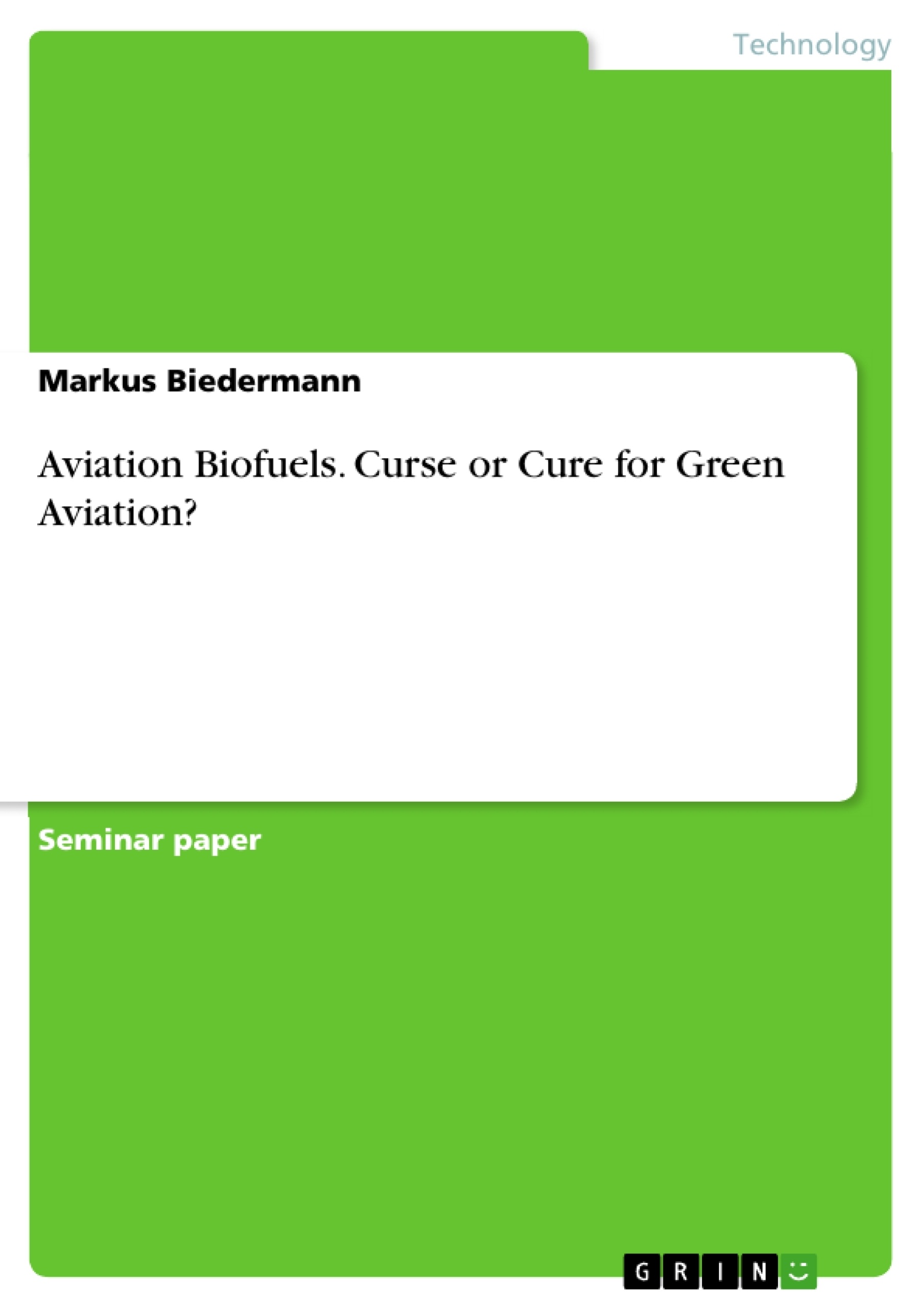The purpose of this paper is to evaluate the challenges and chances of biofuels in an aviation context. It begins by providing a brief history on biofuels in general and in aviation specifically. It is followed by an overview of the main driving forces for the aviation industry to invest in biofuels and their development. After that, different available biofuels and their segmentation in first, second, and third generations is shown in more detail along with a basic overview on the production processes that exist
on the market. Based on the given information, first the challenges and after that, the chances, for the aviation industry on investing in aviation biofuels is shown into detail.
The paper claims that the biofuels still have major issues as there is no real alternative on the market or in development that can substitute crude oil-based jet fuel up to 100%. Current biofuels can only be used as mixtures with conventional jet fuel. However, the biggest issue, namely that biofuels cannot be certified in aviation because of their specifications,
is solved with second-generation biofuels.
The main challenges are still to find a sustainable biofuel that can be used without changes to existing aircraft propulsion technology and nothing ensures that this will be possible in the necessary timeframe until the crude oil finally starts to become less available. That point in time is constantly updated, but only based on statistical data. It is not known at
what point in time this will be exactly.
However, there are a number of opportunities. They range from having an alternative to substitute conventional jet fuel for emission reduction reasons to the investment of an aircraft operator to the production of biofuel itself. This could be for the sake of entering new markets or just to integrate the fuel supply into the company-owned supply chain. The paper concludes that a lot of development still seems to need to be required before a real alternative to conventional jet fuel is available on a large
scale. The most promising approach today is the algae-based fuel.
Inhaltsverzeichnis
- LIST OF FIGURES
- ABBREVIATIONS
- ABSTRACT
- 1. INTRODUCTION
- 2. DEFINITION OF BIOFuel
- 3. HISTORY OF BIOFUELS
- 4. DRIVING FORCES FOR AVIATION BIOFUELS
- 4.1. ECONOMICAL REASONS
- 4.2. EUROPEAN UNION REGULATION
- 5. AVAILABLE AVIATION BIOFUEL APPROACHES
- 5.1. FISCHER-TROPSCH AND THE BIOMASS-TO-LIQUID PROCESS
- 5.2. HYDRO-PROCESSED ESTERS AND FATTY ACIDS
- 5.3. THE CARBON LIFE CYCLE
- 6. CHALLENGES FOR AVIATION BIOFUELS
- 6.1. FOOD PRODUCTION COMPETITION
- 6.2. LAND USE COMPETITION
- 6.3. AVAILABILITY
- 6.4. PRICE VOLATILITY
- 6.5. COMPATIBILITY AND CERTIFICATION
- 7. POSSIBILITIES FOR AVIATION BIOFUELS
- 7.1. CO2 LIFECYCLE AND EU ETS
- 7.2. COST EFFECTIVENESS
- 7.3. INDEPENDENCE OF FUEL PRODUCING COUNTRIES
- 7.4. ENTERING NEW MARKETS
- 7.5. DEALING WITH THE CRUDE OIL SHORTAGE IN THE FUTURE
- 7.6. ALGAE-BASED JET FUEL
- 8. CONCLUSION
- BIBLIOGRAPHY
Zielsetzung und Themenschwerpunkte
This paper aims to evaluate the challenges and opportunities of biofuels in the aviation context. It provides a historical overview of biofuels, both in general and specifically in aviation, and examines the driving forces behind the aviation industry's investment in biofuels and their development. The paper then delves into different available biofuels and their segmentation into first, second, and third generations, along with an overview of existing production processes. Based on this information, the paper explores both the challenges and opportunities for the aviation industry in investing in aviation biofuels.
- The history and development of biofuels in aviation
- The driving forces behind the adoption of biofuels in aviation
- Different types of biofuels and their production processes
- The challenges and opportunities associated with using biofuels in aviation
- The potential of algae-based jet fuel as a sustainable alternative
Zusammenfassung der Kapitel
The paper begins by defining biofuels and outlining their history, both in general and specifically in the aviation industry. It then explores the driving forces behind the adoption of biofuels in aviation, including economic reasons and European Union regulations. The paper then delves into different available biofuels and their segmentation into first, second, and third generations, along with an overview of existing production processes. The paper then examines the challenges associated with using biofuels in aviation, including food production competition, land use competition, availability, price volatility, and compatibility and certification issues. Finally, the paper explores the opportunities associated with using biofuels in aviation, including reducing CO2 emissions, cost effectiveness, independence from fuel-producing countries, entering new markets, dealing with future crude oil shortages, and the potential of algae-based jet fuel.
Schlüsselwörter
The keywords and focus themes of the text include aviation biofuels, sustainable aviation, green aviation, biofuel production, Fischer-Tropsch, biomass-to-liquid, hydro-processed esters and fatty acids, carbon life cycle, food production competition, land use competition, price volatility, compatibility and certification, CO2 emissions, EU ETS, cost effectiveness, independence from fuel-producing countries, entering new markets, crude oil shortage, algae-based jet fuel.
- Quote paper
- Markus Biedermann (Author), 2015, Aviation Biofuels. Curse or Cure for Green Aviation?, Munich, GRIN Verlag, https://www.grin.com/document/294668
-

-

-

-
Upload your own papers! Earn money and win an iPhone X. -

-
Upload your own papers! Earn money and win an iPhone X. -

-
Upload your own papers! Earn money and win an iPhone X. -

-
Upload your own papers! Earn money and win an iPhone X. -

-
Upload your own papers! Earn money and win an iPhone X. -

-
Upload your own papers! Earn money and win an iPhone X. -

-
Upload your own papers! Earn money and win an iPhone X. -

-
Upload your own papers! Earn money and win an iPhone X.

